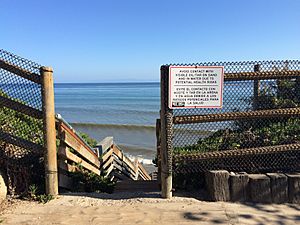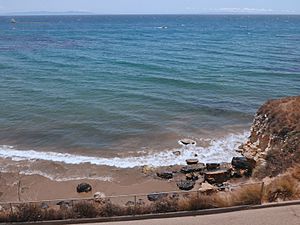Refugio oil spill facts for kids
Quick facts for kids Refugio oil spill |
|
|---|---|

Crude oil washes up on Refugio State Beach
|
|
| Location | Gaviota Coast, north of Santa Barbara, California |
| Coordinates | 34°27′45″N 120°05′11″W / 34.46250°N 120.08639°W |
| Date | May 19, 2015 |
| Cause | |
| Cause | Ruptured pipeline |
| Operator | Plains All American Pipeline |
| Spill characteristics | |
| Volume | 105,000 U.S. gallons (2,500 barrels) |
| Shoreline impacted | 7 miles (11 km) coated with crude oil; tar balls damaged beaches more than 100 miles (160 km) down the coast |
The Refugio oil spill happened on May 19, 2015. It released a large amount of crude oil onto a very special natural area along the West Coast of the United States. This place is known for having many different kinds of plants and animals.
The oil came from a broken underground pipe called Line 901. This pipe was owned by Plains All American Pipeline. It carried oil from offshore platforms to other places for processing. The people in charge of the pipeline in Midland, Texas had turned off an alarm. This alarm would have told them about the leak. They were busy with another problem at the time. The pipe was 28 years old and did not have an automatic shut-off valve. Workers only stopped the leak after other people saw the oil spill and told them about it.
Hundreds of animals along the coast were covered in the thick oil. Many of them died. State parks and beaches nearby had to close for a while. Even though this spill was smaller than the 1969 Santa Barbara oil spill, it might have long-lasting effects. This is because it happened near four state marine protected areas. This area is one of the most studied ocean environments in the United States.
Contents
What Happened After the Spill
Impact on Nature and Animals
The oil spill was much smaller than the big 1969 Santa Barbara oil spill. That spill happened on January 28, 1969, when an oil rig blow-out released millions of gallons of oil.
The thick oil harmed the coats, skin, beaks, and appendages of hundreds of animals. Workers found 202 dead birds and 99 dead mammals. These included at least 46 sea lions and 12 dolphins. We will never know the full number of animals affected. This is because some animals might travel far away before they die from their injuries. Sixty-five live birds and sixty-three live mammals were saved and cared for.
Some of the rescued animals were cleaned and nursed back to health. Ten adult Brown pelicans were released at Goleta Beach. They had spent three weeks being cared for by scientists. In September 2015, SeaWorld San Diego released the last three sea lions affected by the spill. Scientists are now watching some of these animals. They use satellite transmitters to track their movements.
The cleanup happened during the nesting season for snowy plovers. These birds are often found on beaches. Their nests are hard to see in the sand. The birds can easily be scared away by people. This leaves their eggs open to predators like sea gulls. Least terns, another endangered species of bird, were also a worry during the cleanup.
Scientists say that mammals and birds get a lot of attention. But smaller creatures at the bottom of the ocean food chain are also hurt by oil. Animals like mussels, barnacles, and other shellfish cannot move away from the oil. When they touch oil, more than 90% of them can die. It can take many years for their populations to recover.

Researchers from the University of California, Santa Barbara, started collecting samples very soon after the spill. They wanted to see how it affected the marine environment. They kept going back to collect more samples. Luckily, students and researchers had studied this area before. This meant they had information about what the area was like before the spill. A professor named David Valentine said this spill was a chance to learn. They could study how tiny ocean life, oil, and the environment react to each other.
Money Matters After the Spill
Plains All American Pipeline said the cleanup cost them $96 million. The total costs related to the spill were about $257 million. This included the emergency response, cleanup, and money for legal claims. The company said that most of this money would be covered by insurance. The Oil Pollution Act of 1990 says that the company that spills the oil must pay for the cleanup.
The spill also affected the local economy. The county might have lost about $74 million if the pipeline stayed closed for three years. This is because the oil and gas industry in the area depends on this pipeline. Workers' pay and local taxes were reduced while the pipeline was out of service. The impact on tourism was not as bad as expected. Many workers helping with the cleanup even helped some hotels.
After the spill, about 138 square miles (360 km2) of fishing areas were closed. They reopened after six weeks. This happened when health officials said that seafood from the area was safe to eat. The closure affected commercial fishermen. It was hard for them to sell their fish. People thought all seafood from the area might be tainted. There is also a worry that the oil might have destroyed the main food source for some sea life. The Santa Barbara region usually sells a lot of red sea urchin and red rock crab.
Fun and Recreation Affected
The Gaviota Coast is not very crowded, but many people visit for outdoor activities. The spill affected both public and private places there. The state closed El Capitán State Beach for a month. It reopened on June 26 for camping and day use. Refugio State Beach was more damaged. It did not reopen until July 17, 2015. These two popular parks quickly filled up with summer visitors when they reopened. A park superintendent said that half the people did not even know the park had been closed. This showed how clean the park had become.
Legal Actions
About a year after the spill, Plains All American Pipeline faced many legal charges. The California Attorney General said this would send a message to the company and the oil industry.
Local fishermen, who could not fish during the closures, filed lawsuits. Homeowners also sued, saying their property value went down. These lawsuits were combined into a larger lawsuit against Plains. Another lawsuit was filed by people who owned shares in the company. They said Plains gave "false and misleading statements" about how they maintained the pipeline.
In March 2016, a court told Plains to stop misleading people who were asking for money for damages. The court said Plains was tricking victims into giving up their rights to get full payment.
The city of Santa Barbara also sued Plains in May 2016. They asked for $2.1 million. City officials said that news reports made it seem like the spill was in the city of Santa Barbara. But it was actually 20 miles (32 km) away in Santa Barbara County. This stopped visitors from coming during the busy tourist season. The city lost millions of dollars in tax money.
A group called the Environmental Defense Center of Santa Barbara (EDC) asked for records about the pipeline's inspections. They sued the government agency in charge because they did not get the documents for over six months.
In March 2020, a jury found that Plains' careless actions caused the spill. Plains then agreed to pay $60 million for penalties and damages.
Replacing the Pipeline
On August 15, 2017, Plains asked for permission to replace the old pipelines, Line 901 and Line 903. The new pipeline would help transport crude oil again in Santa Barbara, San Luis Obispo, and Kern Counties. The old pipelines cannot be used anymore.


